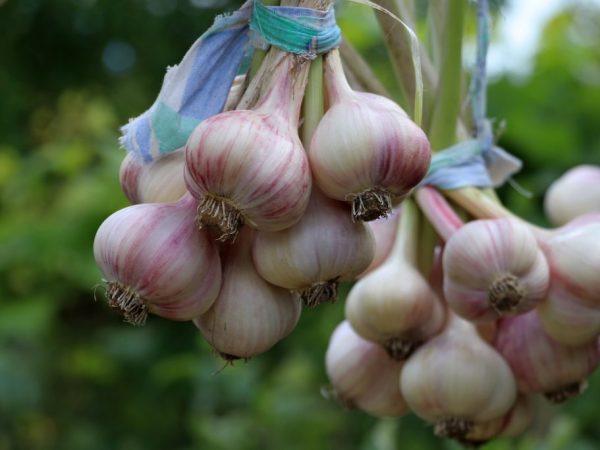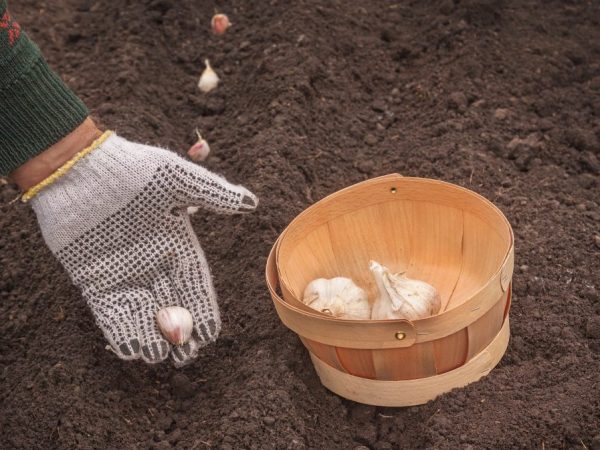Rules for planting winter garlic
Garlic is a perennial bulbous plant that is grown in many countries. Winter garlic, which is planted before winter, is especially popular. They appreciate it for its large heads and teeth and ease of care.

Planting winter garlic
The key to the successful cultivation of such garlic is proper planting and quality care. This will ensure the development of healthy plants that will delight you with a high yield.
Landing dates
To get a high-quality harvest, it is important to observe the timing of planting winter garlic. This type of garlic is planted in the fall. Before the onset of cold weather with sub-zero temperatures, winter garlic should take root well, but not have time to germinate. It takes 30-45 days for full rooting. The timing of planting winter garlic for different regions is significantly different. And can range from mid-September to mid-November. Planting time will depend on the climate and the time of the arrival of the winter cold. According to the experience of gardeners, the best time to plant teeth will be mid-October. He will have time to take root well and build up the root system, which can protect it from freezing.
Planting times will also differ depending on planting depth. If planted to a depth of 5-9 cm, then you need to plant 25 days before the onset of cold weather. With an in-depth planting method, to a depth of 10-15 cm, the teeth can be planted from mid-September to the 20th of October.
Selection of variety and quality planting material
It is important in the process of growing to choose a good variety that will give a high yield, be well stored and show resistance to diseases. Among the popular and those that have established themselves as quality, it is necessary to highlight;
- Sail - belongs to the mid-season varieties. Has high frost resistance. Bulbs weighing up to 50 g, large teeth, covered with a white husk with a violet tinge. Resistant to bacterial rot and nematodes, has an average sensitivity to peronosporosis.
- Belorussky is an early ripening variety with excellent keeping quality. Heads weighing up to 80g with 4-7 teeth, covered with white husk with faint purple stripes. It is rarely affected by rot.
- Lyubasha is a large-fruited variety with rounded bulbs weighing 110-120g. Up to 7 teeth are formed in one head. Well tolerates frosts down to -20 C. Not picky about watering, retains high productivity even during dry summers. Store well. Fusarium resistant.
- Komsomolets is the best of winter hardy garlic varieties. It has a high yield (1.5 kg / sq. M.) And heads weighing 50-110 g, with 9-11 teeth. Sheath color is white with a gray tint. Not demanding on growing conditions. Has an average tolerance to diseases and pests. Resistant to fusarium and various bacterial rot.
Seeds
Choosing a suitable variety, you should be especially careful about the quality of the planting material. Not only yield depends on this, but also resistance to diseases and adverse conditions.When buying prongs for planting, you need to pay attention to some characteristics that indicate quality and affect germination. Prongs suitable for planting:
- large and uniform in size;
- smooth shape, no deformation;
- without signs of disease and traces of rot, mold;
- whole, not injured;
- with an intact bottom.
Choosing a landing site
When choosing a place and a bed for planting winter garlic, you need to take into account soil moisture, illumination, and also what garden crops grew in this place last season. The planting site should be moderately moist and not flooded during the winter or spring thaw, the water in the garden should not stagnate. With stagnant water, planted winter garlic can rot and be intensely affected by fungal diseases. The winter garlic bed should be well lit and not shaded by other vegetables, bushes or trees. Poor lighting and shading affects the size and quality of the crop.
The soil
Many vegetable crops are sensitive to the so-called crop rotation, and garlic is no exception. It needs to be planted in the garden on which such crops used to grow:
- tomatoes;
- beans, beans;
- pumpkin;
- cabbage.
And the beds on which grew onions or potatoes, it is better not to plant winter garlic. Also, a garden bed that has been fertilized with manure will not work, the soil enriched with nitrogen will stimulate the intensive growth of the aboveground green part of the plants, and the growth of the bulb will be limited.
Preparation and landing
Before planting winter garlic, the heads are divided into cloves, the husks are not removed, they are examined for damage. It is best not to use prongs of doubtful quality. After that, they can be treated with saline and a solution of copper sulfate, this will disinfect the planting material and protect against infection of plants with diseases. To prepare a saline solution in 5 liters of water, dissolve 3 tbsp. l. salt, soak the teeth for 2 minutes. And then immersed in a solution of copper sulfate (1 tsp per 10 liters of water) also for 2 minutes. After the procedure, it is washed with clean water and dried.

Observe depth and distance
Planting scheme and depth
For planting, a wide-row or tape landing pattern is used. Such methods simplify the care of the crop and provide sufficient area for plant nutrition.
- In a wide-row planting, the distance between the rows should be 40-45 cm, and the distance between plants in a row should be 15-20 cm.
- With a strip scheme, two rows are planted with a distance of 20 cm and the next row spacing of 45 cm wide.The distance in rows between individual plants is 20 cm.
In small areas, the row spacing can be reduced to 30 cm, and in very small summer cottages up to 20-25 cm, but the distance between plants is increased.
Planting depth plays a huge role in growing technology. Shallow planting often leads to the fact that the heads come to the surface, begins to crumble, and the cloves begin to grow lateral roots, as a result, the crop grows of poor quality. And also landing at insufficient depth leads to freezing in winter or damage during spring frosts. With an unjustifiably deep planting, the germination of the crop becomes difficult, and this is dangerous by delaying ripening and lowering yields.
The deepening is directly related to the planting time, the size of the teeth and the texture of the soil. Planting depth before winter is from 6-9 to 10-13 cm. Medium-sized teeth are planted to a depth of 7-8 cm, and larger ones into grooves 9-10 to 13 cm deep. On light sandy soils, we plant garlic by 2-3 cm deeper.
Planting winter garlic is a responsible process, on which plant growth, quality and yield level depend. The prong must be planted in an upright position, and the bottom must be in close contact with the soil so that it remains in the correct position during sprinkling with earth and begins to root quickly.After planting, it is recommended to compact the soil, especially on light and loose soils. To protect against frost, the garden bed is covered with branches, straw or spruce branches.
Care
Caring for this vegetable crop consists of basic agricultural technology, which includes:
- loosening;
- mulching;
- watering;
- top dressing.
Loosening
After the snow has melted, and the air temperature has stabilized and the average daily temperature began to be 12-15 C, shelters are removed from the beds and the soil is easily loosened. Loosening of the row spacings is carried out every two weeks, this has a beneficial effect on the growth of the plant and the formation of large heads. Loosening is done to a depth of 3-5 cm. This procedure will improve the process of gas exchange and the supply of nutrients.
Mulching
After the first loosening, the bed is mulched; for this, compost or moistened peat is used. This will improve the structure of the soil and serve as the first feeding for young plants.
Watering
Watering winter garlic is necessary during periods of drought and high temperatures. In such conditions, watering is carried out in the morning, once a week. It is better to water in the aisle. During the period of rains and cold snaps, watering is reduced or completely eliminated. Waterlogging of the soil at low temperatures leads to decay and disease. Watering is stopped a month before the harvest.
Fertilizer
Top dressing of winter garlic is carried out three times per season. In early spring, after removing the shelter and loosening, and two in the summer with an interval of 14-21 days between them. For feeding, it is better to use organics and preparations with a mild effect:
- Table salt (30 ml per 10 l of water) accelerates development, prevents yellowing and drying, use a solution at the rate of 3 l / m2. It disinfects the ground and prevents the multiplication and spread of nematodes, filamentous worms.
- Wood ash is used in a dry solution and dissolved in water. Dry ash is scattered over the moistened soil in row spacing per 1 sq. m. 3-4 tbsp is enough. l. To prepare a solution, a glass of ash is added to 10 liters of water, and the plants are watered with the resulting top dressing.
- Ammonia. To prepare the solution, add 2 tbsp to a bucket of water. l. ammonia. You can shed a garden bed or spray plants with such a top dressing. The ammonia will provide plants with nitrogen and is also a preventive pest control.
In industrial cultivation, mineral fertilizers such as urea, nitrophoska and superphosphate are used for feeding. This type of dressing must be applied in compliance with the dosage recommended by the manufacturer.
Conclusion
The basis for productive cultivation of winter garlic is proper planting. It is held in the fall, when the main processes in the beds have already been completed. A careful approach to planting winter garlic, adherence to sowing dates and proper care allow you to get high yields.


